

Home - The Australian Fisheries Management Authority (AFMA) Rio 2016: Swimmers need to ingest only three teaspoons of water to be almost certain of contracting a virus. Just days ahead of the Olympic Games the waterways of Rio de Janeiro are as filthy as ever, contaminated with raw human sewage teeming with dangerous viruses and bacteria, according to a 16-month-long study commissioned by the Associated Press.
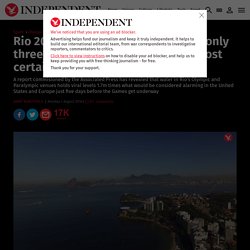
What's in Rio's Bay and Beaches? From the top of Rio de Janeiro’s Sugarloaf or the Christ the Redeemer statue that towers above the city, Guanabara Bay looks picturesque.

But the ailing estuary, site of the Olympic’s sailing and rowing, is anything but pristine. Roughly 16 million people live around the bay, making it one of the world’s most densely populated urban areas. Many neighborhoods lack proper sanitation, causing squalid water conditions, including raw sewage and extreme levels of disease-causing microorganisms in Guanabara Bay. Athletes have complained the water is littered with trash, and that it irritates their skin and causes stomach ailments. Some teams have instructed Olympic rowers to avoid splashing water on each other and to carry hand sanitizer onboard their boats.
These water pollution problems aren’t unique. Yet it isn’t often that such water pollution captures media attention on an Olympic scale.
Australian Recommendations. The seafood economy — Marine Stewardship Council. Processing clams from Ben Tre fishery, Vietnam. © Kyle Cathie Millions of people work in the seafood industry, contributing to local, regional and global trade on a massive scale and maintaining jobs.

It's not just about fishing. Seafood-related jobs include processing, packing, transport, retail and restaurants. Through these diverse businesses, the seafood economy generates financial security for individuals and a valuable source of GDP. Image result for info graphic pollution ocea. Image result for brazil water pollution infographi. Trash Pollution : Ocean Health Index. How Was It Measured?
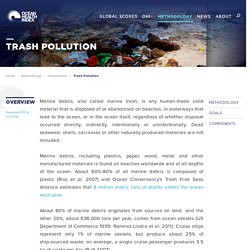
The Clean Water goal is unusual because its four components--Trash Pollution, Nutrient Pollution, Chemical Pollution and Pathogen Pollution--indicate both Status and Pressure. Low levels of those factors produce a high goal score, but high levels produce a low score. For example, perfectly clean water has no trash pollution, so Status for this component is expressed as 1 - Trash Pollution. Status for the other components is similarly expressed.
Beginning in 2015 input data for Trash was obtained from Eriksen et al. (2014). Why the Great Barrier Reef is Dying. Fish of every imaginable colour race between the corals as the sun’s rays dance through the ocean’s surface.
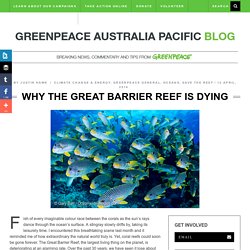
A stingray slowly drifts by, taking its leisurely time. I encountered this breathtaking scene last month and it reminded me of how extraordinary the natural world truly is. Yet, coral reefs could soon be gone forever. The Great Barrier Reef, the largest living thing on the planet, is deteriorating at an alarming rate. Over the past 30 years, we have seen it lose about 50% of its coral. Understanding what is actually causing the reef to die can seem overwhelming given all the various reasons. Coal. Abbot Point. Located 25 km north-west of Bowen on Queensland’s north coast, Abbot Point is placed between the existing industrial centres of Townsville to its north, and Mackay to its south.

It is also adjacent to the Abbot Point State Development Area (APSDA), a 16,320 hectare site for dedicated industrial development. Abbot Point has currently one operating terminal, Adani Abbot Point Terminal (AAPT or T1). Abbot Point: Federal Government approves huge coal port expansion near Great Barrier Reef. Updated Federal Environment Minister Greg Hunt has given the go-ahead to the expansion of the Abbot Point Coal Terminal near Bowen in north Queensland, making it one of the world's largest coal ports.
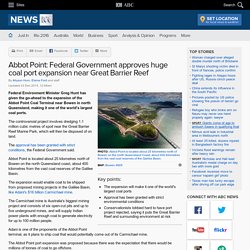
Key points: Sustainable Development Goals Explained: Life Below Water. Environment Protection and Biodiversity Conservation Act 1999 (EPBC Act) Home Page. SDG 14: Life below water. A local fisherman’s boat in the waters off Atauro Island, Timor-Leste.
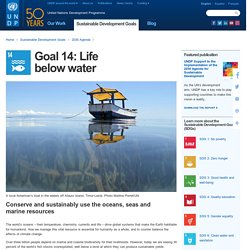
Photo Martine Perret/UN The world’s oceans – their temperature, chemistry, currents and life – drive global systems that make the Earth habitable for humankind. How we manage this vital resource is essential for humanity as a whole, and to counter balance the effects of climate change. Over three billion people depend on marine and coastal biodiversity for their livelihoods.
However, today we are seeing 30 percent of the world’s fish stocks overexploited, well below a level at which they can produce sustainable yields. Oceans also absorb about 30 percent of the carbon dioxide produced by humans, and we are seeing a 26 percent rise in ocean acidification since the beginning of the industrial revolution. The Sustainable Development Goals (SDGs) create a framework to sustainably manage and protect marine and coastal ecosystems from land-based pollution, as well as address the impacts of ocean acidification. Bunurong Marine Park. The broad rock platforms and underwater reefs of Bunurong Marine Park support a remarkable range of habitats, containing a diverse array of plants and animals.
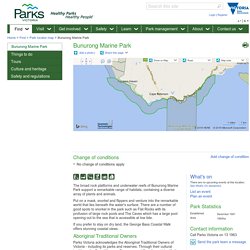
Put on a mask, snorkel and flippers and venture into the remarkable world that lies beneath the water's surface. Oceans - United Nations Sustainable Development.